Tragia durbanensis
Tragia durbanensis, the stinging nettle creeper, is a twining herb in the family Euphorbiaceae,[1] with a restricted distribution in southern Africa.[2] There are some 150 species in the genus Tragia.[3]
| Stinging nettle creeper | |
|---|---|
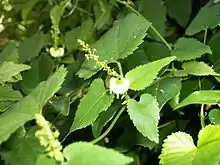 | |
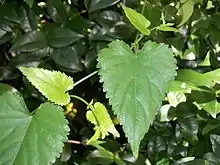 | |
| T. durbanensis from Athlone Park, Amanzimtoti, South Africa | |
| Scientific classification | |
| Kingdom: | Plantae |
| Clade: | Tracheophytes |
| Clade: | Angiosperms |
| Clade: | Eudicots |
| Clade: | Rosids |
| Order: | Malpighiales |
| Family: | Euphorbiaceae |
| Genus: | Tragia |
| Species: | T. durbanensis |
| Binomial name | |
| Tragia durbanensis | |
| Synonyms | |
|
See text | |
Distribution and habitat
It is native to the coastal areas of Mozambique and eastern coastal areas of South Africa.[1] These plants are found in dune forest,[4] in woodland and on forest margins.[1]
Description
A much-branched climbing perennial herb, with twining stems up to 2.5 m originating from a woody rootstock.[5] The leaves are hairless or thinly hairy with serrated margins.[1] The hairs sting fiercely.[1] Inflorescences are up to 5.5 cm long with peduncles up to 2 cm long.[5] The inflorescences are composed mostly of tiny[1] male flowers with 1–2 female flowers below or else all male.[5]
Synonyms
- Tragia capensis E.Mey. ex Sond. [Illegitimate name]
- Tragia glabrata (Müll.Arg.) Pax & K.Hoffm. [Illegitimate name]
- Tragia glabrata var. hispida Radcl.-Sm.
- Tragia meyeriana var. glabrata Müll.Arg.
Ecological significance
This species is one of the larval foodplants of four species of butterfly; Eurytela hiarbas, Eurytela dryope, Byblia ilithyia and Byblia anvatara.[6]
Gallery
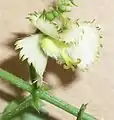 Female flower
Female flower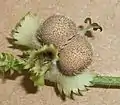 Fruit viewed from the side
Fruit viewed from the side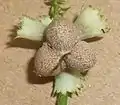 Fruit viewed from the front
Fruit viewed from the front
References
- Pooley, E. (1998). A Field Guide to Wild Flowers; KwaZulu-Natal and the Eastern Region. ISBN 0-620-21500-3.
- Swaziland's Flora Database: Tragia glabrata (Müll.Arg.) Pax & K.Hoffm. var. glabrata: http://www.sntc.org.sz/flora/speciesinfo.asp?spid=1670, retrieved 1 March 2011.
- http://www.theplantlist.org/tpl1.1/search?q=Tragia
- JSTOR PLANT SCIENCE: Entry for Tragia glabrata var. glabrata [family EUPHORBIACEAE]: http://plants.jstor.org/flora/fz7111, retrieved 1 March 2011.
- JSTOR PLANT SCIENCE: Entry for Tragia glabrata Müll. Arg. Pax & K. Hoffm. [family EUPHORBIACEAE]: http://plants.jstor.org/flora/fz7110, retrieved 1 March 2011.
- Williams, M. (1994). Butterflies of Southern Africa; A Field Guide. Southern Book Publishers. ISBN 1-86812-516-5.